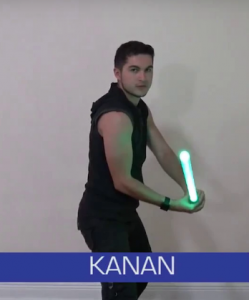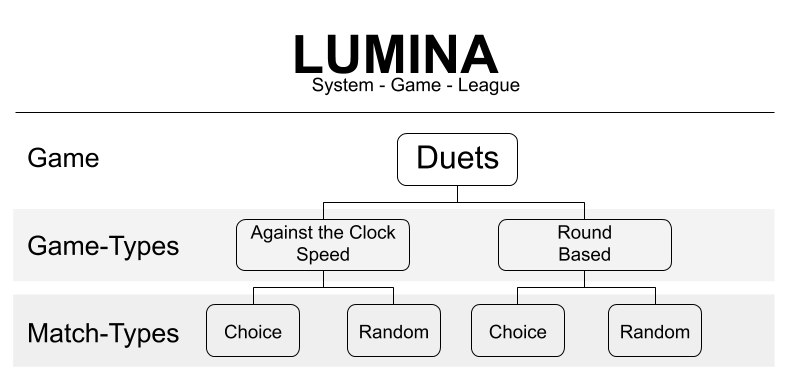
Lumina Duets is a LUMINA game type where participants, also known as Lumens, compete in teams against each other for points in timed or numbered rounds. The goal is for each team to successfully complete as many CMs as they can. Each successfully played & defended CM earns the team points. Each team’s Lumens work together to achieve the highest amount of points in a round. Each round, a Team of Lumens face off and points are accumulated. Points are counted as successfully committed and defended CMs. The objective of each Team is to obtain the highest amount of points. The winners are the team with the highest score at the end of the game. The winner of the game is the team that completes the last round with the most points.
Rules:
- Play must be conducted in a 30x30 square arena.
- Determine how many rounds are needed to end the match: 4, 8, 12 or specify if it is a timed match, e.g. a 2-minute match with unlimited number of rounds.
- Each round is consisted of turns which are consisted of exchanges..
- A turn is where 1 participant engages against the other player using either 1 CM or up to 2 CMs (in a PowerPlay) of choice.
- Participants switch role as attacker after each turn.
- Attacker must telegraph to Defender of incoming CM.
- CMs are pre-assigned combinations of points. Each CM is a different value and divided into 3 categories:
- Simple CMs are worth 1 point.
- Advanced CMs are worth 2 points.
- Extended CMs are worth 3 points.
- Styled pauses & locks are also counted as steps.
- Interrupting pauses nulls points in turn. Team is awarded points if attacker and defender successfully complete the CM the attacker intended.
- Points are awarded to the team, not the players.
- Attackers must step forward.
- Defenders must step backwards.
- If attacker forgets a strike or defender misses the attack, the CM is invalid and the turn switches to the defender. See Recovery in our Additional Rules online.
CMs can be played in combinations resulting in a “Power Play” for an additional point. Attacker must combine 2 different telegraphs prior to engaging in the attack. A maximum of 2 CMs can be played consecutively. Power Play points are granted to the winner of the turn. Depending on the complexity determines the points. - For example:
2 Simple CMs: +1 = 3 Total Points
Example: CM A (worth 1 point) + CM H (worth 1 point) PLUS +1 for the Power Play results in a total of 3 points for that turn.
1 Simple + 1 Advanced: +1 = 4 Total Points
Example: CM A (worth 1 point) + CM G (worth 2 points) PLUS +1 for the Power Play results in a total of 4 points for that turn.
2 Advanced CMs: +1 = 5 Total Points
Example: CM I (2 points) + CM J (2 points) PLUS +1 for the Power Play results in a total of 5 points.
1 Advanced CM + 1 Extended CM: +1 = 6 Total Points
Example: CM J (2 points) + CM K (3 points) PLUS +1 for the Power Play results in a total of 6 points.
2 Consecutive Extended forms: +1 = 7 Total Points
Example: CM E (3 points) + CM K (3 points) PLUS +1 for the Power Play results in a total of 7 points.
Striking participant incurs a penalty upon injury to partner. The worse the injury, the worse the penalty. Minimum penalty is 1 point, maximum penalty is disqualification.
Matches should be non-verbal. Recovery must be non-verbal. - Powerplays are always a modifier of +1Individual Lumina chapters may develop their own CM chart and point allocation system as long as all Lumens are familiar with the recognized CMs.
Simple: +1
- CM-A
- CM-H
Advanced: +2
- CM-B
- CM-C
- CM-G
- CM-I
- CM-J
- CM 11
- CM 12
- CM 13
Extended: +3
- CM-D
- CM-E
- CM-F
- CM-K
- CM-L
- CM-O
- CM 14
Against the Clock
- CM-A
- CM-H
Rounds Based
- CM-B
- CM-C
- CM-G
- CM-I
- CM-J
- CM 11
- CM 12
- CM 13
How to play:
- Gather 2 participants
- Flip a coin for opening attacker
- Begin timer or Set number of rounds
- Participant A telegraphs a CM of choice to Participant B
- Both engage
- Upon successfully completing the CM or a mistake occurring, the turn is over and roles switch
- Participant B telegraphs a CM of choice to Participant A
- Both engage
- Upon successfully completing the CM or a mistake occurring, the turn is over and roles switch
- Repeat until timer or number of rounds is completed
- Determine points based on CMs & Powerplay combinations.
How to win:
- Winning team of players is team that achieves the most amount of points in a given match.
- Tournaments may be played in brackets with singles or doubles.
Judging:
- Only 2 players: Use a camera/phone to capture the match and make the judgement calls after the fight.
- 3+ players: Have at least 1 player watch and make the judgement calls.
How to get prepared:
- Learn the forms & the telegraphs
- Practice in Accelerators
Example Play:
Advanced Play

Fundamentals Play











